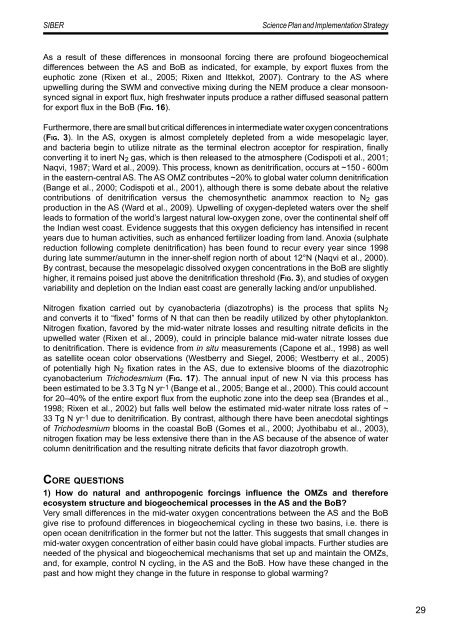SIBER SPIS sept 2011.pdf - IMBER
SIBER SPIS sept 2011.pdf - IMBER
SIBER SPIS sept 2011.pdf - IMBER
Create successful ePaper yourself
Turn your PDF publications into a flip-book with our unique Google optimized e-Paper software.
<strong>SIBER</strong><br />
Science Plan and Implementation Strategy<br />
As a result of these differences in monsoonal forcing there are profound biogeochemical<br />
differences between the AS and BoB as indicated, for example, by export fluxes from the<br />
euphotic zone (Rixen et al., 2005; Rixen and Ittekkot, 2007). Contrary to the AS where<br />
upwelling during the SWM and convective mixing during the NEM produce a clear monsoonsynced<br />
signal in export flux, high freshwater inputs produce a rather diffused seasonal pattern<br />
for export flux in the BoB (Fig. 16).<br />
Furthermore, there are small but critical differences in intermediate water oxygen concentrations<br />
(Fig. 3). In the AS, oxygen is almost completely depleted from a wide mesopelagic layer,<br />
and bacteria begin to utilize nitrate as the terminal electron acceptor for respiration, finally<br />
converting it to inert N 2 gas, which is then released to the atmosphere (Codispoti et al., 2001;<br />
Naqvi, 1987; Ward et al., 2009). This process, known as denitrification, occurs at ~150 - 600m<br />
in the eastern-central AS. The AS OMZ contributes ~20% to global water column denitrification<br />
(Bange et al., 2000; Codispoti et al., 2001), although there is some debate about the relative<br />
contributions of denitrification versus the chemosynthetic anammox reaction to N 2 gas<br />
production in the AS (Ward et al., 2009). Upwelling of oxygen-depleted waters over the shelf<br />
leads to formation of the world’s largest natural low-oxygen zone, over the continental shelf off<br />
the Indian west coast. Evidence suggests that this oxygen deficiency has intensified in recent<br />
years due to human activities, such as enhanced fertilizer loading from land. Anoxia (sulphate<br />
reduction following complete denitrification) has been found to recur every year since 1998<br />
during late summer/autumn in the inner-shelf region north of about 12°N (Naqvi et al., 2000).<br />
By contrast, because the mesopelagic dissolved oxygen concentrations in the BoB are slightly<br />
higher, it remains poised just above the denitrification threshold (Fig. 3), and studies of oxygen<br />
variability and depletion on the Indian east coast are generally lacking and/or unpublished.<br />
Nitrogen fixation carried out by cyanobacteria (diazotrophs) is the process that splits N 2<br />
and converts it to “fixed” forms of N that can then be readily utilized by other phytoplankton.<br />
Nitrogen fixation, favored by the mid-water nitrate losses and resulting nitrate deficits in the<br />
upwelled water (Rixen et al., 2009), could in principle balance mid-water nitrate losses due<br />
to denitrification. There is evidence from in situ measurements (Capone et al., 1998) as well<br />
as satellite ocean color observations (Westberry and Siegel, 2006; Westberry et al., 2005)<br />
of potentially high N 2 fixation rates in the AS, due to extensive blooms of the diazotrophic<br />
cyanobacterium Trichodesmium (Fig. 17). The annual input of new N via this process has<br />
been estimated to be 3.3 Tg N yr-1 (Bange et al., 2005; Bange et al., 2000). This could account<br />
for 20–40% of the entire export flux from the euphotic zone into the deep sea (Brandes et al.,<br />
1998; Rixen et al., 2002) but falls well below the estimated mid-water nitrate loss rates of ~<br />
33 Tg N yr-1 due to denitrification. By contrast, although there have been anecdotal sightings<br />
of Trichodesmium blooms in the coastal BoB (Gomes et al., 2000; Jyothibabu et al., 2003),<br />
nitrogen fixation may be less extensive there than in the AS because of the absence of water<br />
column denitrification and the resulting nitrate deficits that favor diazotroph growth.<br />
Co r e q u e s t i o ns<br />
1) How do natural and anthropogenic forcings influence the OMZs and therefore<br />
ecosystem structure and biogeochemical processes in the AS and the BoB<br />
Very small differences in the mid-water oxygen concentrations between the AS and the BoB<br />
give rise to profound differences in biogeochemical cycling in these two basins, i.e. there is<br />
open ocean denitrification in the former but not the latter. This suggests that small changes in<br />
mid-water oxygen concentration of either basin could have global impacts. Further studies are<br />
needed of the physical and biogeochemical mechanisms that set up and maintain the OMZs,<br />
and, for example, control N cycling, in the AS and the BoB. How have these changed in the<br />
past and how might they change in the future in response to global warming<br />
29












